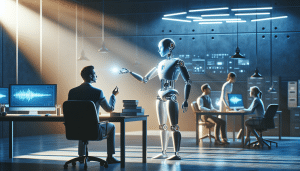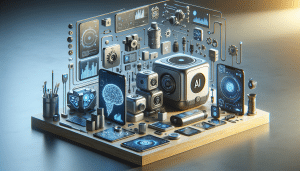Do You Really Understand Artificial Intelligence
Aiden Foster October 23, 2025
Artificial intelligence is shaping daily life in subtle and powerful ways. Uncover the exciting realities behind AI’s growing influence, how it impacts various industries, and what future shifts may mean for everyday technology. This in-depth guide breaks down AI’s true capabilities and emerging trends through practical examples and clear insights.
AI in Everyday Life: Not Just Science Fiction
Artificial intelligence, often called AI, is now found in everything from personal devices to search engines. Virtual assistants like Siri or Alexa use AI algorithms to recognize your voice and answer questions. Many people don’t realize that, when you receive personalized recommendations on streaming platforms, those suggestions are powered by machine learning—a branch of AI that finds patterns in data to make smarter decisions every time you interact with technology.
The use of AI doesn’t stop at entertainment or simple commands. In many homes, smart thermostats and connected lighting systems automatically adjust themselves based on sensed movement, learned preferences, or even weather forecasts. This AI-driven automation helps reduce energy use while making daily routines more efficient. Security cameras also harness AI to tell the difference between family members and potential intruders, providing alerts and videos only when truly needed.
Beyond convenience, AI’s influence can be seen in the way devices respond to changing needs. Many smartphones now have built-in image recognition and background optimization features powered by deep learning, making photos clearer and apps faster. In short, AI is integrated into all sorts of technology around you—often without any special setup or extra fees. As AI quietly powers more tools, life can become smoother and more tailored to your habits.
How Machine Learning Drives Breakthroughs
Machine learning, a core pillar of AI, has transformed industries like banking, health, and transportation. For example, banks now use machine learning systems to process thousands of daily transactions and spot suspicious activity or potential fraud much faster than human analysts. The same technology can predict loan risks, manage portfolios, and answer routine customer questions through automated chatbots. These breakthroughs allow organizations to serve clients more efficiently and securely.
In healthcare, AI-powered diagnostics tools help medical teams interpret scans and spot conditions earlier. Machine learning algorithms are trained on vast pools of patient data to detect subtle patterns, enabling faster and sometimes more accurate assessments for conditions such as cancer or cardiovascular disease. The result is a revolution in preventive care, where early intervention has become more achievable due to AI’s growing accuracy (Source: https://healthit.gov/healthcareai).
Transportation also benefits tremendously from AI advances. Self-driving vehicles rely on deep neural networks to process real-time sensor data, recognize obstacles, and navigate safely. Machine learning helps delivery companies optimize routes by analyzing traffic patterns or weather, saving both fuel and time. The underlying AI improvements enable these systems to continuously learn from their environments and self-correct as needed.
The Human Side of AI: Benefits and Ethical Dilemmas
As AI becomes deeply embedded in society, its impact goes beyond convenience—it raises important ethical and social questions. Many companies now use AI-driven hiring tools to sift through job applications, aiming to reduce bias and find suitable candidates efficiently. However, some worry that poorly designed algorithms may unintentionally reflect or even amplify existing human biases. Creating fair, transparent AI remains a key goal for developers, as people expect new technology to align with human values.
Another benefit of AI is accessibility. Voice recognition and natural language processing, for example, give people with disabilities new ways to interact with devices, open applications, and even control home features hands-free. These improvements help create a more inclusive society while highlighting the need for ongoing innovation. Still, the trade-off can involve privacy concerns if AI collects sensitive data, so maintaining user trust is crucial (Source: https://ed.gov/aiinclusion).
Regulation is an emerging area as governments and organizations address responsible AI deployment. Parliaments and technical experts have started to draft guidelines and policies to encourage transparency, fairness, and accountability. These frameworks seek to ensure that, as AI becomes more pervasive, it serves the public good and minimizes harm when possible. It’s a balancing act—advancing technological capability while respecting individual rights and social norms.
The Role of Data: Feeding AI’s Growth
The secret to AI’s growing abilities lies in data—lots of it. Every time a virtual assistant answers a question or an image recognition app sorts photos, it draws on extensive datasets collected from millions of users. AI developers rely on diverse, high-quality data to train their models, so the systems become smarter and more effective with experience. This cycle, called supervised learning, continually refines an AI’s skill set.
But collecting and storing all that information raises questions about privacy and security. Responsible organizations are beginning to adopt “data minimization” practices, keeping only the information needed to provide a better experience. Some tech companies also use encryption and anonymization to help protect users’ identities, aligning their efforts with regulations like GDPR (Source: https://ico.org.uk/for-organisations/guide-to-data-protection/guide-to-the-general-data-protection-regulation-gdpr/).
Increasing data literacy—helping people understand how information is used by AI—can empower users to make better choices about their technology use. Many educational platforms now offer courses that demystify big data, AI, and privacy issues (Source: https://www.coursera.org/specializations/ai-for-everyone). As the world becomes more data-centric, learning these skills can be essential for personal and professional growth.
Trends to Watch: What’s Next for Artificial Intelligence
The pace of AI innovation shows no sign of slowing. One rapidly evolving area is generative AI, where systems can create new content—including art, music, and even text—by learning from past examples. These tools have the potential to transform creative industries, making it easier to bring original ideas to life. But their rise has also sparked debates over copyright, ownership, and the line between machine and human creativity.
Another significant trend is AI’s growing role in climate modeling and environmental protection. Researchers are now using advanced algorithms to analyze satellite images, predict natural disasters, and track changes in ecosystems. This level of insight supports better decision-making in conservation and urban planning, helping societies address complex global challenges (Source: https://climate.nasa.gov/news/analyticsai).
Finally, the growing field of explainable AI aims to make advanced decision-making more transparent. As AI is used in high-stakes areas like criminal justice or medical diagnostics, developers are creating systems that show their reasoning in clear language. By providing “decision trails,” these tools can help people understand—and trust—AI’s choices, bridging the gap between technical complexity and everyday understanding.
Preparing for an AI-Focused Future
Continuous learning is key to thriving amid AI advancements. As more jobs require data-driven or technical skills, courses and workshops in AI literacy, computational thinking, and ethical reasoning are beginning to appear everywhere from universities to online platforms. These learning resources encourage adaptation and resilience for those navigating a changing workforce (Source: https://www.edx.org/learn/artificial-intelligence).
Collaboration between humans and intelligent machines is also on the rise. Many jobs now integrate AI as a tool—whether in customer support, design, or logistics. Being open to working alongside smart systems, rather than seeing them just as replacements, can unlock powerful benefits. As these partnerships evolve, people will discover new ways to create value and foster innovation.
Staying informed and engaged with technological changes is easier than ever. Reputable news outlets and academic sources regularly publish updates on AI’s impact, helping the public form thoughtful opinions and prepare for coming trends. Exploring these insights can make a big difference, allowing individuals and communities to harness AI for progress and shared benefit.
References
1. Office of the National Coordinator for Health Information Technology. (n.d.). Artificial Intelligence in Healthcare. Retrieved from https://healthit.gov/healthcareai
2. U.S. Department of Education. (n.d.). Artificial Intelligence and Inclusion. Retrieved from https://ed.gov/aiinclusion
3. UK Information Commissioner’s Office. (n.d.). Guide to the General Data Protection Regulation (GDPR). Retrieved from https://ico.org.uk/for-organisations/guide-to-data-protection/guide-to-the-general-data-protection-regulation-gdpr/
4. Coursera. (n.d.). AI For Everyone Specialization. Retrieved from https://www.coursera.org/specializations/ai-for-everyone
5. NASA. (n.d.). Analytics and Artificial Intelligence for Climate. Retrieved from https://climate.nasa.gov/news/analyticsai
6. edX. (n.d.). Learn Artificial Intelligence. Retrieved from https://www.edx.org/learn/artificial-intelligence








